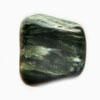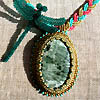- sale
- new items
- lovely beads
- wedding beads
- beads for teens
- for custom order
- newsletter
- recognition
- testimonials
- birthstones
- zodiac signs
- jewelry guide
SHOP BAG
![]() in your bag 0 items
in your bag 0 items
Not many people have ever heard about actinolite that is a silicate mineral. The name "actinolite" is derived from the Greek word AKTIS, meaning "beam" or "ray" because of the mineral's fibrous nature. Fibrous actinolite is one of the six recognised types of asbestos, the fibres being so small that they can enter the lungs and damage the alveoli. Actinolite asbestos was once mined along Jones Creek at Gundagai, Australia.
Simple actinolite occasionally forms interesting crystal habits and specimens. Crystals can be similar to hornblende, but are always translucent or even transparent. Typically they are prismatic, flattened and elongated. Crystal specimens of actinolite can make very interesting mineral specimens.
Some forms of actinolite are used as gemstones. One is nephrite, one of the two types of jade (the other being jadeite). Jade has been used in China and Central America as an ornamental and religious stone of deep significance. The nephrite jade was used mostly in China, although both have been used in both regions. Nephrite is more abundant than jadeite and has few color varieties, ranging only from creamy white to green.
Another gem variety is the chatoyant form known as cat's-eye a ctinolite. This stone is translucent to opaque, and green to yellowish green color. This variety has had the misnomer jade cat's-eye. Transparent actinolite is rare and is faceted for gem collectors. Major sources for these forms of actinolite are Taiwan and Canada. Other sources are Madagascar, Tanzania, and the United States.



